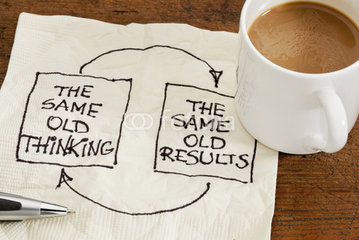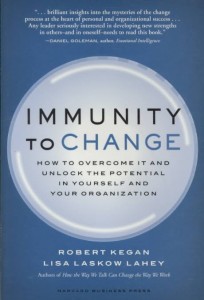How long did you stick with your New Year’s resolution in 2015? And in 2014? Polls indicate that if you only made it to the end of January you were in good company. Almost 80{f09be4e68a790078494bad402d1ee2d268ae90cb41c80aba0f70f560181e9b3f} of people who make a New Year’s resolution fail to achieve it.
According to Kegan and Lahey, the main reason so many of us fail is because we focus on changing behaviour, when we should work on changing our mindset. I like their analogy of wanting IT to do something different: sometimes we can make that happen by adding on new hardware or downloading an app; other times we won’t be able to use the new hardware or app unless we get a whole new operating system.
The following steps to achieve lasting change are based on Kegan and Lahey’s Immunity to Change framework.
Step 1: Define your change goal
It must be a behaviour, something that you want to do, rather than something that you want to stop doing, and it must be a change that you have to make yourself. It’s about what you do, not what you are.
Claire is a triathlete. Here’s her change goal:
I’m going to change how I swim so that in a triathlon my effort level is a 3 on a 5 point scale, so that I go into the bike stage feeling full of energy.
Step 2: List the things you do now that work against this change goal
Here, list as many things as you can think of. You don’t need to explain them.
Claire’s list looks like this:
- When I train in the pool I try to build my muscular strength, aerobic capacity and endurance – I kick hard and pull hard, and try to do more lengths every swim.
- My effort level is always high: 4 or 5.
- In a triathlon I maintain an effort level of 5.
Step 3: Imagine trying to do the opposite of your behaviours in Step 2
What would be the worst thing about that for you – how does it feel? Then, turn these fears around – to protect yourself from those feelings, what do you need to do?
| Claire’s fears | Claire’s commitments to self-protection |
| Swimming more slowly than usual so: Feeling a failure
Feeling stupid Looking stupid to others Feeling humiliated Feeling defeated if I admit that all my effort isn’t helping |
I’m committed to not feeling a failure.
I’m committed to not feeling stupid. I’m committed to not looking stupid I’m committed to not feeling humiliated I’m committed to being successful in everything I do |
At this point, you are probably feeling stuck, because your change goal and commitments are pushing you in opposite directions. That’s good – you’re getting a better understanding of why it’s so hard to make this change.
Step 4: Identify your underlying assumptions
Brainstorm all the assumptions that might underlie the fears and commitments in Step 3. Some of these may seem to be causes, and others consequences of those fears and commitments.
Some of Claire’s assumptions:
- If I swim at a lower effort level, my times will get slower.
- Swimming at less than full effort is a waste of time, stupid.
- If I swim more slowly, I’ll feel a failure.
- Other people notice what I’m doing in the pool, and in the triathlon.
- I care what other people think.
If the assumptions you’ve identified are true for you, they make the commitments inevitable, and generate your current behaviours. So it’s no wonder it’s hard to stop doing what you do now.
And Step 5?
That’s where you take action to learn whether or not your assumptions are true. If they aren’t all as true as you think, then you have no need to continue doing the things you do now that prevent you from achieving your goal.
Keep an eye on our updates for suggestions on how to test your assumptions. In the meantime, what do you learn about yourself by working through the first four steps?


